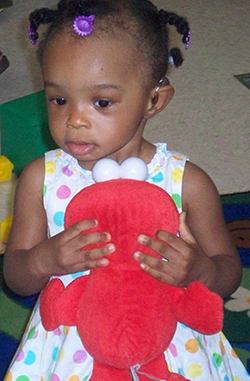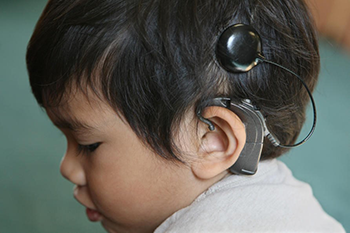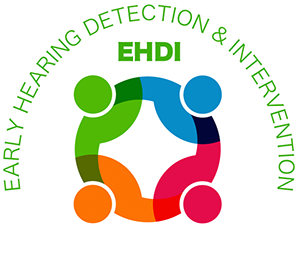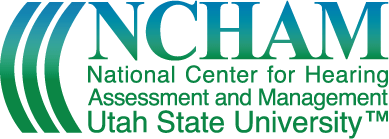Last Modified: 06/15/2023
Download PDF of
this Information
Data Sharing Partnerships Improve Systems
Produced in collaboration with:




Partnerships between the Early Hearing Detection and Intervention (EHDI) program and Part C of the Individuals with Disabilities Education Act (IDEA) program can support and improve outcomes for children who are deaf or hard of hearing (DHH) and their families. Collaboration between these programs is specified in the IDEA Part C Regulations 34 CFR §303.302(c)(ii)(J) and strengthened in P.L. 115-71, EHDI Act of 2017.
Federal Requirements
IDEA requires that the state child find system is coordinated with specific agencies including the EHDI programs. The primary referral sources must refer a child to the Part C program as soon as possible but not later than seven days after the child has been identified. Screening, evaluation and assessment, and the initial IFSP meeting must be completed within 45 days.
EHDI programs were designed to assure that all deaf or hard of hearing children born in the United States and U.S. territories receive the services they need to prevent developmental delay as early in life as possible.
EHDI programs work to accomplish this objective by promoting hearing screening in the first month of life, diagnosis and hearing loss identification no later than three months of age, and entry into Early Intervention (EI) no later than six months of age.

Data Sharing Agreements Between EHDI and Part C
Data sharing agreements should include a description of activities with sufficient specificity to make clear what will and what will not be shared between the two programs, and the safeguards needed to protect the privacy of the child and family. This must include a description of how any Personally Identifiable Information (PII) from Part C early intervention records will be used.
See also: Procedural Safeguards: Confidentiality, Technology and Privacy
To support the exchange of information between Early Hearing Detection and Intervention (EHDI) and Part C of the Individuals with Disabilities Education Act (IDEA), the National Center for Hearing Assessment and Management (NCHAM) in collaboration with the Center for IDEA Early Childhood Data Systems (DaSy) and the Early Childhood Technical Assistance Center (ECTA) has gathered information from states regarding the agreements used to share information between EHDI and Part C of IDEA.
Data sharing between EHDI and Part C can promote:
- Seamless systems that allow families to focus on the supports they need rather than the process,
- Data-informed decisions that can greatly reduce guesswork
- Informed evaluation and program improvement, and
- Meaningful stakeholder engagement.
While almost everyone agrees data sharing between EHDI and Part C is beneficial, some states find it difficult to reach agreement on procedures for sharing data that appropriately protect personally identifiable information (PII) and are consistent with federal and state requirements. In many instances, states have developed written agreements between agencies to outline their procedures for data sharing. In other instances, states use parental permission to obtain consent to share these data.
Below are state examples provided with state permission. These are organized by:
- FERPA Data Sharing Agreements and Other Memoranda for Data Sharing
- Coordinated Referral Forms
We welcome examples from additional states. If you would like to share, please email your documents to ntrc.helpdesk@usu.edu so that they can be posted on this page to serve as valuable examples to states and territories.

Examples of Data Sharing Agreements and Other Memoranda for Data Sharing
- Arizona – Data Sharing Agreement [PDF]
- Connecticut - Memorandum of Agreement [PDF]
- Florida – Data Use Agreement [PDF]
- Idaho – Interagency Agreement [PDF]
- Iowa Data Sharing Agreement [PDF]
- Louisiana – Data Sharing Agreement [PDF]
- Massachusetts – Memorandum of Agreement [PDF]
- Michigan – Sample Data Sharing Agreement [PDF]
- Missouri – Interagency Agreement [PDF]
- New Jersey – Data Sharing Agreement [PDF]
- Oklahoma – Reporting Rules [PDF]
- Pennsylvania – Memorandum of Agreement [PDF]
- Utah – Data Sharing Agreement [PDF]
- Washington – Information Sharing Agreement [PDF]
- Wisconsin – Memorandum of Understanding [PDF]
Examples of Referral Forms
States have worked together to develop consent forms that reduce the number of individual forms needed to exchange information among providers who are serving families. Click on the links below to learn about individual state’s policies and practices.
- Hawaii – Release of Information Form [DOC]
- Idaho – Release of Information Form [PDF]
- Mississippi – Release of Information Form [PDF]
- Missouri – Explanation of Request for Parental Consent [PDF]
- Virginia – Part C Referral Form [PDF]
- Nebraska – Release of Information Form [PDF]
- Washington – Resource Referral Form [DOCX]
When data sharing between systems is seamless, families can focus on the supports they need rather than the process.
For State and local entities, data sharing leads to data-informed decisions and greatly reduces guesswork.
Providing and sharing data promotes informed decisions to evaluate and improve programs, services, and meaningful Stakeholder Engagement.
Data that is shared publicly is aggregated, therefore, no personally identifiable information is released.
The Bridge Between EHDI and IDEA
The effectiveness of early identification of children who are deaf or hard of hearing (DHH) rests in what happens after the initial identification has been completed. The EHDI system focuses on early identification and then bridges to the early intervention system that is supported by law:
"Congress finds that there is an urgent and substantial need— to enhance the development of infants and toddlers with disabilities, to minimize their potential for developmental delay, and to recognize the significant brain development that occurs during a child's first 3 years of life."
The Individuals with Disabilities Education Act (IDEA), 2004
The link between these two systems is the shared recognition of the child as a unique individual whose strengths and needs must be clearly and accurately identified and whose family is empowered to express their questions, concerns, knowledge, hopes, and dreams that ultimately inform decisions made by the family.
The use of quality EHDI, early intervention and education data enables policymakers, administrators, educators, service providers and parents to design and implement effective practices to improve child and family outcomes.
See also: DaSy Data Culture Toolkit
EHDI programs were designed to assure that all DHH children born in the United States and its territories receive the services they need to prevent developmental delay as early in life as possible. IDEA Part C also assures that all eligible children receive services.
Data Sharing Resources
Centers

The Early Childhood Technical Assistance Center (ECTA) supports IDEA Part C (infants and toddler) and Section 619 (preschool) programs in developing high quality early intervention and preschool special education service systems, increasing local implementation of evidence-based practices, and enhancing outcomes for young children with disabilities and their families.

The Center for IDEA Early Childhood Data Systems (DaSy) works with states to support IDEA early intervention and early childhood special education state programs in building high quality data systems and using data to improve results for young children with disabilities and their families.

Hands & Voices is a parent-driven organization that supports families with children who are deaf or hard of hearing without bias. They also promote family engagement and leadership programs through The H&V Family Leadership in Language & Learning Center.

The National Center for Hearing Assessment and Management (NCHAM) at Utah State University serves as the Early Hearing Detection and Intervention, National Technical Resource Center (EHDI NTRC) funded by Maternal and Child Health Bureau (MCHB) of the Health Resources and Services Administration (HRSA) at the United States Department of Health and Human Services. The purpose of the EHDI NTRC is to provide support to EHDI programs in states and territories also funded by HRSA. The EHDI NTRC helps EHDI programs ensure that children who are deaf or hard of hearing are identified through newborn, infant, and early childhood hearing screening and receive the diagnostic and early intervention services they need.
Documents
Position Statements from the Joint Committee on Infant Hearing
Year 2019 Position Statement: Principles and Guidelines for Early Hearing and Detection and Intervention Programs Journal of Early Hearing Detection and Intervention, 4(2), 1-44. DOI: https://doi.org/10.15142/fptk-b748
EHDI Guidance Manual
Chapter 1 of this CDC guidance manual can help you to:
- Understand the purpose of having a complete EHDI Information System (EHDI-IS);
- Define what a basic and complete EHDI-IS looks like with regard to its data and functional requirements;
- Understand the importance of the link between planning and evaluation;
- Think about the role of program stakeholders; and
- Consider the critical elements important to your system's sustainability.


